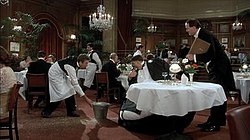You are using an out of date browser. It may not display this or other websites correctly.
You should upgrade or use an alternative browser.
You should upgrade or use an alternative browser.
Re-Hydrate v Not..
- Thread starter Ducatiboy stu
- Start date

Help Support Australia & New Zealand Homebrewing Forum:
This site may earn a commission from merchant affiliate
links, including eBay, Amazon, and others.
GalBrew
Well-Known Member
Basically, what happens is if the solution that you are rehydrating yeast (or any cell for that matter) in has a lower concentration of dissolved solutes (salts, sugars, etc) than the interior of the yeast cell, this solution will flow into the yeast cell in an attempt to restore osmotic equilibrium and rupturing the cell membrane in the process. If on the other hand the solution has a higher concentration of dissolved solutes than the interior of the yeast cell, water from the yeast cell will diffuse out through the cell membrane into the 'rehydrating fluid' again in an attempt to restore osmotic equilibrium (extracellular space.....whatever) also killing the yeast cell. To have no net flow of water in or out of the yeast cell, would require an isotonic solution (0.9% saline as mentioned previously would probably work fine).Dengue said:seems what this is leading to
In summary:
wort is poisonous if absorbed through the cell wall prior to biomechanical machinery kicking in
pure water will cause the cells to pop like an over inflated balloon
so yes maybe somewhere in between is the answer.
I'd like to see a controlled experiment on this.
In the meantime, seems I better use liquid yeast till I figure this out. :huh:
Keeping this in mind it is correct to say that tap water, that has a whole bunch more crap dissolved in it than distilled water has less of an osmotic imbalance, but I would say not that much. The mere fact that yeast can be rehydrated with sterile tap water is testament to how f@cking robust these cells are.
Ducatiboy stu
Well-Known Member
- Joined
- 2/4/05
- Messages
- 14,268
- Reaction score
- 3,832
Re-hydrating Mr Creasote


Dengue
Active Member
- Joined
- 30/7/13
- Messages
- 44
- Reaction score
- 2
Please doth summarise thou wisdom ?Yob said:The answer has been stated many times just some don't accept it.

Ducatiboy stu
Well-Known Member
- Joined
- 2/4/05
- Messages
- 14,268
- Reaction score
- 3,832
Start at page 1
Dengue
Active Member
- Joined
- 30/7/13
- Messages
- 44
- Reaction score
- 2
you know the answer do you mate ?Ducatiboy stu said:Start at page 1
Dengue
Active Member
- Joined
- 30/7/13
- Messages
- 44
- Reaction score
- 2
Dengue said:you know the answer do you mate ?
mje1980 said:You cannot be ******* serious

Ducatiboy stu
Well-Known Member
- Joined
- 2/4/05
- Messages
- 14,268
- Reaction score
- 3,832
I am not even sure I know the questionDengue said:you know the answer do you mate ?
Dengue
Active Member
- Joined
- 30/7/13
- Messages
- 44
- Reaction score
- 2
Oh sorry, it wasn't even a question.Ducatiboy stu said:When using dry yeast I have never seen the need to re-hydrate first. Especially if done in plain water. The yeast will hydrate just as well in the ferm, if not better. Remember water has no nutrients so wont help it along. The wort has everything it needs to hydrate and get to work
Ducatiboy stu
Well-Known Member
- Joined
- 2/4/05
- Messages
- 14,268
- Reaction score
- 3,832
well why the **** did you ask.....Dengue said:Oh sorry, it wasn't even a question.
Thefatdoghead
Well-Known Member
I rehydrated some WB-06 today. I only did it because I really hate the noise the yeast make when you pitch them dry. That screaming sound like a live lobster straight in the boiling pot.
Similar threads
- Replies
- 9
- Views
- 3K
- Replies
- 0
- Views
- 1K






